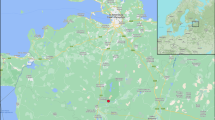Abstract
In the process of bioremediation in the soil contaminated by different oil concentrations, the changes in the microbial numbers (bacteria and fungi) and the enzyme (catalase (CAT), polyphenol oxidase (PPO) and lipase) activities were evaluated over a 2-year period. The results showed that the microbial numbers after 2-year bioremediation were one to ten times higher than those in the initial. The changes in the bacterial and the fungal populations were different during the bioremediation, and the highest microbial numbers for bacteria and fungi were 5.51 × 109 CFU g−1 dry soil in treatment 3 (10,000 mg kg−1) in the initial and 5.54 × 105 CFU g−1 dry soil in treatment 5 (50,000 mg kg−1) after the 2-year bioremediation period, respectively. The CAT and PPO activities in the contaminated soil decreased with increasing oil concentration, while the lipase activity increased. The activities of CAT and PPO improved after the bioremediation, but lipase activity was on the contrary. The CAT activity was more sensible to the oil than others, and could be alternative to monitor the bioremediation process.



Similar content being viewed by others
References
Bolan NS, Duraisamy VP (2003) Role of inorganic and organic soil amendments on immobilization and phytoavailability of heavy metals: a review involving specific case studies. Aust J Soil Res 41:533–555
Curl EA, Truelove B (1986) The rhizophere. Springer, New York, pp 9–54
Del Val C, Barea JM, Azcón-Aguilar C (1999) Assessing the tolerance to heavy metals of arbuscular mycorrhizal fungi isolated from sewage sludge-contaminated soils. Appl Soil Ecol 11:261–269
Entry JA, Wood BH, Edwards JH, Wood CW (1997) Influence of organic by products and nitrogen source on chemical and microbiological status of an agricultural soil. Biol Fertil Soils 24:196–204
García-Gil JC, Plaza C, Soler-Rovira P, Polo A (2000) Longterm effects of municipal solid waste compost application on soil enzyme activities and microbial biomass. Soil Biol Biochem 32:1907–1913
Guan SM (1986) Soil enzyme and research method[M]. Agriculture Press, Beijing, pp 274–339
Lin X, Li P, Zhou QX, Xu HX, Zhang HR (2004) Microbial changes in rhizospheric soils contaminated with petroleum hydrocarbons after bioremediation. J Environ Sci 16:987–990
Lin X, Li XJ, Li PJ, Li F, Zhang L, Zhou QX (2008) Evaluation of plant–microorganism synergy for the remediation of diesel fuel contaminated Soil. Bull Environ Contam Toxicol 81:19–24
Madejón P, Murillo JM, Marañón T, Cabrera F, López R (2001) Elementos traza en gramíneas afectadas por el vertido tóxico de las minas de Aznalcóllar. Invest Agr Prod Prot Veg 16:429–446
Madejón E, Burgos P, López R, Cabrera F (2003) Agricultural use of three organic residues: effect on orange production and on properties of a soil of the “Comarca Costa de Huelva” (SW Spain). Nutr Cycl Agroecosys 65:281–288
Maliszweska-Kordybach B, Smreczak B (2003) Habitat function if agricultural soils as affected by heavy metals and polycyclic aromatic hydrocarbons contamination. Environ Int 28:719–728
Margesin R, Zimmerbauer A, Schinner F (2000) Monitoring of bioremediation by soil biological activities. Chemosphere 40:339–346
Obbard P (2001) Ecotoxicological assessment of heavy metals in sewage sludge amended soils. Appl Geochem 16:1405–1411
Pankhurst CE, Hawke BG, McDonald HJ, Kirkby CA, Buckerfield JC, Michelsen P, O’Brien KA, Gupta VVSR, Doube BM (1995) Evaluation of soil biological properties as potential bioindicators of soil health. Aust J Exp Agr 35:1015–1028
Tordoff GM, Baker AJM, Willis AJ (2000) Current approaches to the revegetation and reclamation of metalliferous wastes. Chemosphere 41:219–228
Zhou QX, Song YF (2004) Principles and methods of contaminated soil remediation. Science Press, Beijing, pp 556–560
Acknowledgments
This research was supported by funds provided by Innovative Program of The Chinese Academy of Sciences (KZCX2-YW-446), the National High Technology Research and Development Program of China (2007AA06A405), National Natural Science Foundation of China (20807029), and National Basic Research Program of China (2004CB418506).
Author information
Authors and Affiliations
Corresponding author
Rights and permissions
About this article
Cite this article
Lin, X., Li, X., Sun, T. et al. Changes in Microbial Populations and Enzyme Activities During the Bioremediation of Oil-Contaminated Soil. Bull Environ Contam Toxicol 83, 542–547 (2009). https://doi.org/10.1007/s00128-009-9838-x
Received:
Accepted:
Published:
Issue Date:
DOI: https://doi.org/10.1007/s00128-009-9838-x




